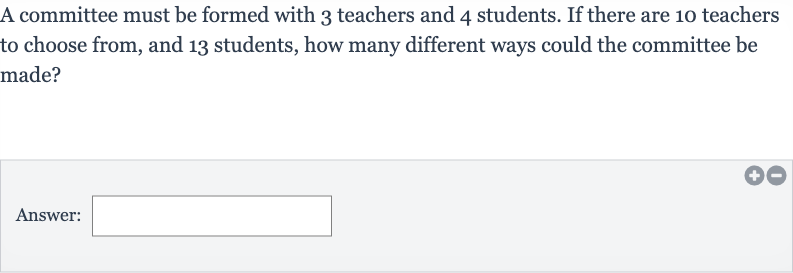Full solution
Q. A committee must be formed with teachers and students. If there are teachers to choose from, and students, how many different ways could the committee be made?Answer:
- Calculate Teachers Combinations: To determine the number of different ways to form the committee, we need to calculate the combinations of teachers and students separately and then multiply them together. For the teachers, we will use the combination formula which is , where is the total number of items to choose from, is the number of items to choose, and denotes factorial.
- Calculate Students Combinations: First, we calculate the number of ways to choose teachers out of . Using the combination formula, we get .
- Calculate Total Combinations: Calculating the factorials, we get , , and . We can simplify the combination formula by canceling out the common terms in the numerator and the denominator.
- Calculate Total Combinations: Calculating the factorials, we get , , and . We can simplify the combination formula by canceling out the common terms in the numerator and the denominator.After simplification, . So there are ways to choose teachers from .
- Calculate Total Combinations: Calculating the factorials, we get , , and . We can simplify the combination formula by canceling out the common terms in the numerator and the denominator.After simplification, . So there are ways to choose teachers from .Next, we calculate the number of ways to choose students out of . Using the combination formula, we get .
- Calculate Total Combinations: Calculating the factorials, we get , , and . We can simplify the combination formula by canceling out the common terms in the numerator and the denominator.After simplification, . So there are ways to choose teachers from .Next, we calculate the number of ways to choose students out of . Using the combination formula, we get .Calculating the factorials, we get , , and . Again, we can simplify the combination formula by canceling out the common terms.
- Calculate Total Combinations: Calculating the factorials, we get , , and . We can simplify the combination formula by canceling out the common terms in the numerator and the denominator.After simplification, . So there are ways to choose teachers from .Next, we calculate the number of ways to choose students out of . Using the combination formula, we get .Calculating the factorials, we get , , and . Again, we can simplify the combination formula by canceling out the common terms.After simplification, . So there are ways to choose students from .
- Calculate Total Combinations: Calculating the factorials, we get , , and . We can simplify the combination formula by canceling out the common terms in the numerator and the denominator.After simplification, . So there are ways to choose teachers from .Next, we calculate the number of ways to choose students out of . Using the combination formula, we get .Calculating the factorials, we get , , and . Again, we can simplify the combination formula by canceling out the common terms.After simplification, . So there are ways to choose students from .To find the total number of different ways to form the committee, we multiply the number of ways to choose the teachers by the number of ways to choose the students: (ways to choose teachers) (ways to choose students).
- Calculate Total Combinations: Calculating the factorials, we get , , and . We can simplify the combination formula by canceling out the common terms in the numerator and the denominator.After simplification, . So there are ways to choose teachers from .Next, we calculate the number of ways to choose students out of . Using the combination formula, we get .Calculating the factorials, we get , , and . Again, we can simplify the combination formula by canceling out the common terms.After simplification, . So there are ways to choose students from .To find the total number of different ways to form the committee, we multiply the number of ways to choose the teachers by the number of ways to choose the students: (ways to choose teachers) (ways to choose students).Multiplying these together, we get . Therefore, there are different ways to form the committee.
More problems from Counting principle
QuestionGet tutor help
QuestionGet tutor help
QuestionGet tutor help
QuestionGet tutor help
QuestionGet tutor help
QuestionGet tutor help
QuestionGet tutor help
QuestionGet tutor help
QuestionGet tutor help

